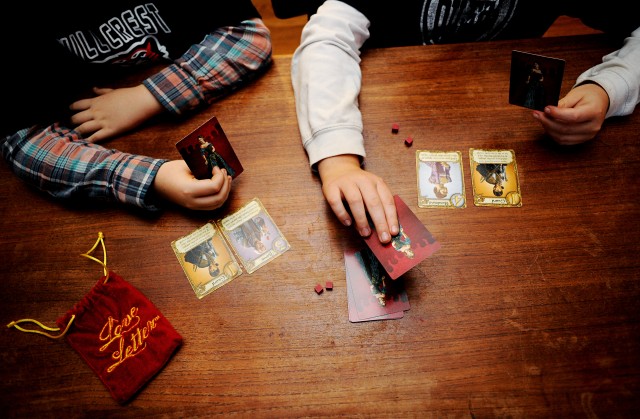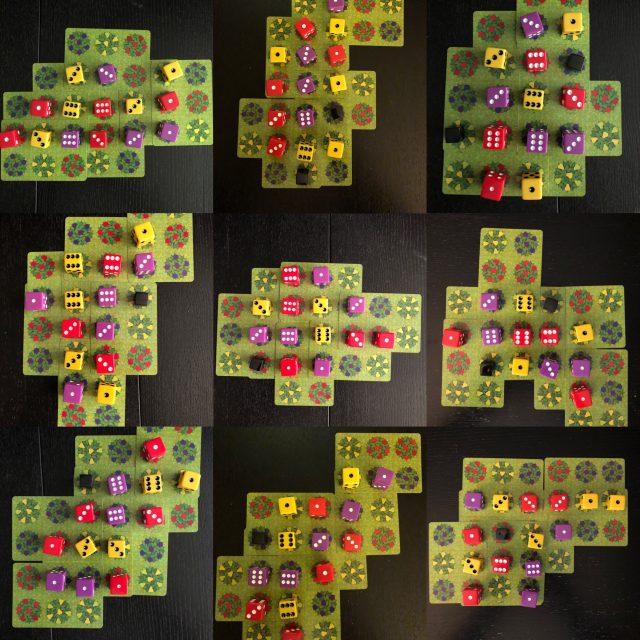Over a year ago I coined the term “TARDIS game” to describe games that packed a big punch (in terms of gameplay) inside a small box with few components. TARDIS games are like Robert Sabuda’s pop-up books: they open up and unfurl like beautiful multi-layered flowers. But the games I want to talk about today are the tabletop equivalent of artisanal potato chips: quirky, flavourful snacks crafted with love.
The term “microgame” has has been around for awhile. In the 1970’s various wargame publishers tried to fight the trend of “monster games” that took forever to play with games that came in ziploc bags, had only a few pages of rules, played in an hour or two–and, most importantly, were cheap to produce and therefore were much more affordable. SPI published a series of what they called “Capsule Games”; Metagaming had a series that included a little game called Ogre about massively-armed tanks that continues to be played today.
But in the modern sense I first heard the term in relation to 2012’s Love Letter. Here was a game of sixteen cards–sixteen!–along with a few cubes and crystals, which provided a very entertaining fifteen to twenty minutes worth of gameplay.
Love Letter has proven to be a very robust design, spawning a ton of rethemed versions based on Xmas, Batman, Munchkin, and so on. And having proved the concept, other microgames entered the field: Coin Age, Tides of Time, and Koba Yakawa to name but a few.

Perhaps unsurprisingly, the genre began in Japan and is arguably best embodied by Japanese designers. Love Letter’s designer, Seiji Kanai, has gone on to design other Microgames such as BraveRats and Lost Legacy. There is something Zen-like and minimalist about creating a game which chops away everything but the very central core of a game, and which embraces the challenge of doing the most with the very least.
Like nanofiction or flash fiction, microgames provide much lower barriers to entry for fledgling creators, and have spawned a cottage industry of self-publishing, including annual contests. Many are available free or cheaply for print-and-play, or can be ordered from The Game Crafter for reasonable prices.
I want to focus on two such games this week because I believe they embody the very best in terms of the microgame aesthetic. The first is very new: 2018’s Orchard: A 9 card solitaire game and yes, that is its official name on BGG. Actually, it’s a smart move, because if your reaction was anything like mine it went like this: (1) “What a stupidly long name!” (2) “Whaaa? A nine card game? NINE CARDS? This I have to see.”
So I sent away for a copy via Grame Crafter and it soon arrived in a little tuckbox. I actually felt a little disappointed and cheated to find eighteen cards in the box (“You promised nine cards!”) along with a bunch of dice in three colours and two black cubes.
It turns out that yes, Orchard has eighteen cards–but you only use half of them for any given game, so technically it’s not a lie. But is it a game?

Oh yes, most certainly yes. Yes, it is.
Each of the cards has a different pattern of six trees using three colours. You start the game with one card on the table and two in hand. Every turn you MUST play a card that at least partially overlaps the cards you’ve already placed. What you’re trying to do to score points is to only overlap trees of the same colour. The more overlapping you do over successive turns, the more points you score. The only randomness is in the draw of the cards; the dice are used only to place on trees you have successfully overlapped to mark your score. Twice (and only twice) during the game, you can mismatch colours, which you then mark with one of those black cubes (“rotten fruit” in game parlance), which are worth negative points if you use them. Once placed, black cubes may not be covered again.
That’s basically it–but that’s really all you need. To me Orchard is the perfect little puzzler. It is the epitome of simple but complex design, where the game is nothing but interesting decisions. Everything else has been sublimated away. Designer Mark Tuck deserves high praise for this game, and I hope he gets the recognition he deserves for hit.
The second game I want to spotlight is Sprawlopolis, by Button Shy games. It promises a co-operative (or solo) city-building experience using–once again–only eighteen cards. I purchased the PnP version from their website because it was cheaper. I know my home-glued cards don’t do full justice to the game, but they’re certainly evidence that you can still enjoy a great game without AAA components.
At game’s start choose three cards (randomly or otherwise) and flip them over; each has a different goal on back which will gain (or occasionally lose) you points at game’s end. Each also has a unique handicap between 1 and 18; adding the three numbers together gives you your target score for that game. One card is played to the middle to start the city grid, the starting player gets three cards, and everyone else gets one card.
Played cooperatively, players take turns adding a card to the grid from their hand and then passing the rest around the table. Cards may overlap previously-played ones or not. Once all fifteen cards have been played, your score is tallied. Aside from points from goals, you always score points for the largest contiguous areas of each colour and LOSE points for each road. Usually this encourages large zones and as few roads as possible, but some of the goals reward you more for diverging from this. Because every player always has at least one “secret” card (which cannot be divulged) no one player can boss everyone around (ie, no “Pandemic Effect”). Played solitaire, you just have a hand of three and keep drawing.

The first time I play a given Sprawlopolis “scenario” solitaire I just try my best and generally fail horribly, but I gain insight into what my strategy should be next time. I immediately reshuffle (with the same three goals) and play again, this time thinking hard, burning brain cells—and do marginally better (and sometimes worse!). The third time through, I slow down incredibly, having figured out what my city needs to look like overall when I’m done, thinking sometimes for two minutes for each play, and THEN manage to eke out a win. Sometimes it takes another play or two. But the whole process takes less then an hour, if that, and it’s incredibly satisfying when I succeed. That, my friends, is a sign of a great solitaire game.
Every set of three goals (there are 816 different possible trios, do the math) means no two games will incentivize the same strategy. So like Orchard, Sprawlopolis balances between elegantly simple and puzzly-hard. It ain’t Sim City, but if you’re willing to spring for some expansions you get even more gameplay.
Which brings me to Button Shy’s other games. ‘Cos you see they seem to have carved out a charming little niche to themselves of microgames (they call them Wallet Games), all of which are available in PnP and physical versions and all of which are at least pretty good and in one case (Circle the Wagons) approach the excellence of Sprawlopolis. Circle the Wagons also has cards with goals on back, but adds a neat card-drafting mechanic but is for two players only (though there is a solitaire expansion Lone Cowboy). Both were designed by the trio of Steven Aramini, Danny Devine, and Paul Kluka. Designer troikas are quite rare, but these guys have something good going.
They may not have the sexiness of Ameritrash games to draw amazed onlookers to your table, but microgames have portability and bang-for-your-buck gameplay on their side. Every collection should have at least a couple.
Comments
No comments yet! Be the first!